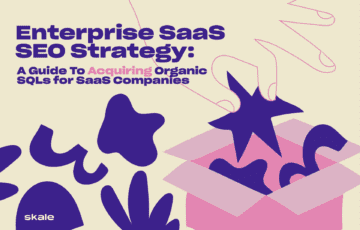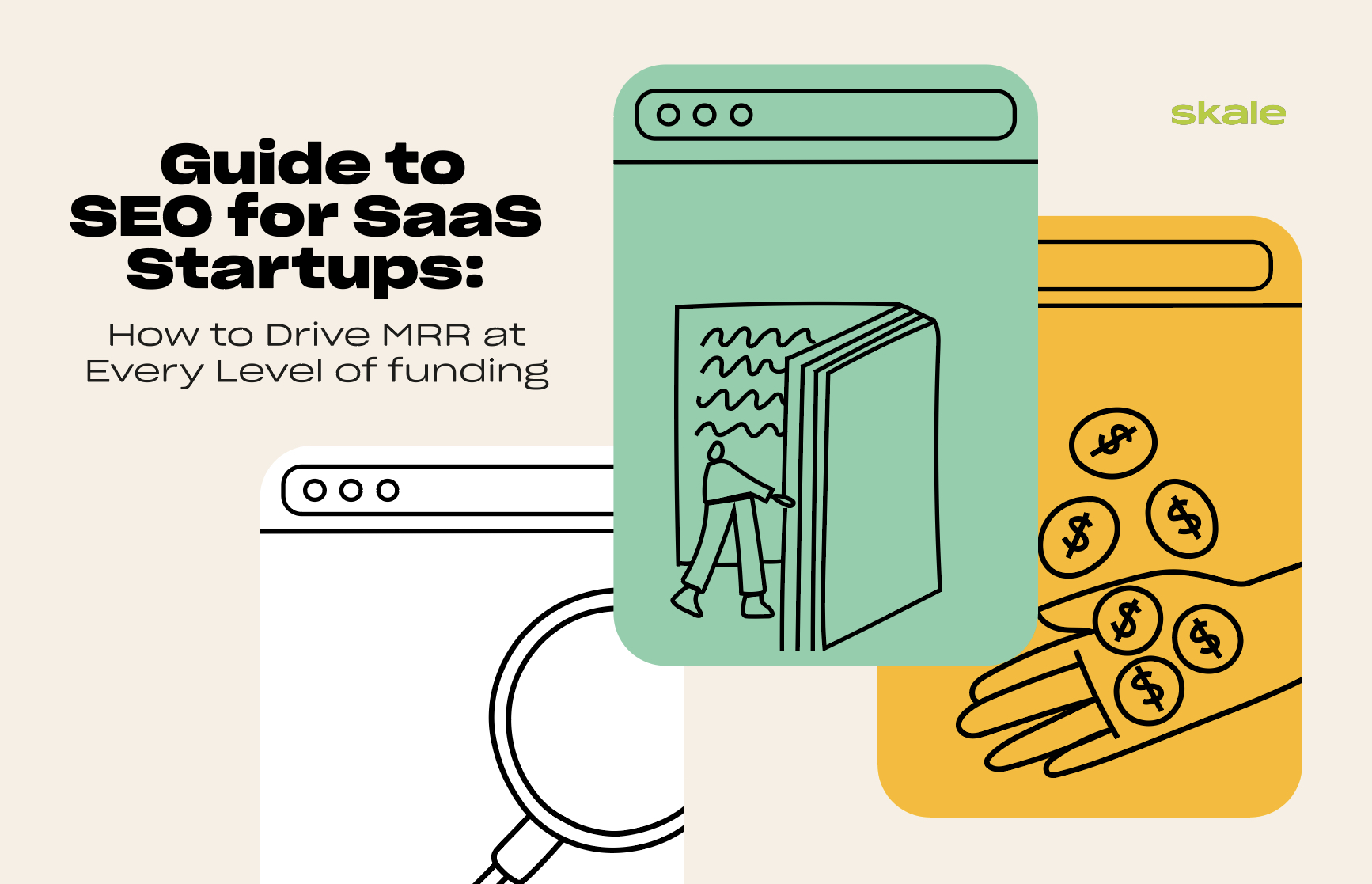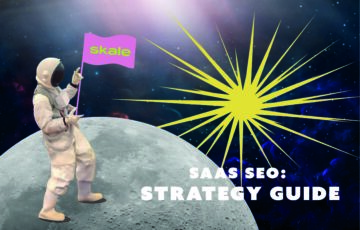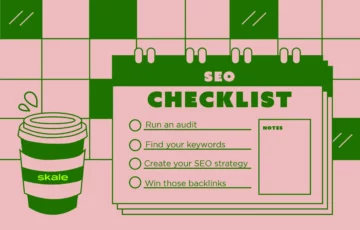
Enterprise SaaS SEO Strategy: A Guide to Acquiring Organic SQLs for SaaS Companies
Unlock the power of Enterprise SaaS SEO with tried-and-tested strategies from the experts & explore SEO tactics for SaaS enterprises.

Embarking on a SaaS startup adventure often feels like being swept into a whirlwind journey of twists and turns, laden with both exciting prospects and daunting challenges.
SEO can sail in as the wind beneath your wings, lifting your startup to unprecedented heights throughout your growth stages.
This guide plunges into the nitty-gritty of SEO, specifically tailored for SaaS startups at distinct funding milestones. It unfolds a roadmap from pre-seed beginnings to all the way through the high-stakes rounds of Series A, B, C, and beyond.
Picture this guide as your trusty navigation partner, steering your SaaS vessel around funding-stage obstacles while illuminating the SEO beacons to catapult your growth and bolster your MRR. Though the voyage might be tough, stay with us — it will prove rewarding.
Ready? Let’s set sail!
SaaS SEO refers to the specialized optimization strategies used by SaaS companies to improve their online brand presence, attract quality traffic, and stimulate organic growth through search engines. Ahem, Google.
SaaS SEO poses unique challenges and opportunities, especially for startups. SaaS companies often operate in a hyper-competitive environment, and their offerings — usually complex cloud-based applications — are not as straightforward to market as a tangible product.
For startups, which often crunch for resources and strive to demonstrate growth potential to investors, implementing a tailored SEO strategy can provide valuable leverage. Yet, there’s always high pressure to deliver on results fast — and SEO is notorious for being a ‘long game’.
With various funding stages requiring some different tactics and expected levels of growth, these SEO strategies look different across various funding stages. For example, an early-stage startup may focus more on establishing a robust SEO foundation and brand awareness, while a mature, series-B funded startup could concentrate on ramping up demand capture and capitalizing on branded search.
Understanding your startup’s specific needs and funding stage is crucial for a successful SEO strategy and execution.
Before diving into the nuts and bolts of SaaS SEO strategy, let’s bust some myths and highlight the benefits that an effective SEO plan can offer your SaaS website:

Skale boosted Rezi’s revenue by 176% in just four months with powerful SaaS SEO tactics
How did we do it?Despite these benefits, some misconceptions are deterring SaaS startups from investing in SEO. One common myth is that SEO isn’t as valuable or immediate as paid advertising.
The reality, however, is that while SEO can take a little time to show results, its impact is long-lasting and cost-effective, making it a perfect investment for many startups as soon as they, well, start! SEO is not just about driving any traffic, it’s about bringing in the right traffic — your ICP — those that are most likely to become paying customers.
Another misconception is the excessive fixation on rankings. While rankings are important to monitor as a leading indicator, the focus should be on deeper-funnel conversions and the quality of traffic, as these more directly impact your bottom-line metrics like MRR.
SEO is a powerful catalyst for growth, but it comes with its own hurdles.
Let’s dive deeper into these challenges and discuss solutions to help you navigate this landscape.
Quick wins are enticing and achievable, at least to a certain extent. For instance, optimizing or linking to pages already showing results, but not yet in top positions or reaching their full potential. However, the most significant impact of SEO unfolds over the long term.
So how do you convince stakeholders to invest resources in SEO? The key is to communicate the long-term benefits and ROI potential of SEO.
Showcase industry statistics, competitor success stories, and projected forecasts to strengthen your business case, making it clear that SEO is an investment, not an expense.
To further drive home the value of SEO, case in point: Attest, a series B consumer research platform, was operating in a highly competitive market and needed to drive monthly organic sign-ups to scale cost-effectively. They engaged Skale’s SEO solutions to meet this challenge.
With detailed keyword research, content optimization, creating new landing pages, and strategic link-building, Skale helped Attest to spike their non-brand organic product signups by an impressive 8.5x year-on-year and bump up their non-brand organic traffic by 1.85x. This significant growth showcases how a well-directed SEO strategy can quickly become a critical engine for business expansion.
This real-world example shows that SEO is not merely an expense; rather, it’s a strategic investment with the potential for substantial returns. Like any investment, building momentum takes time, but the tangible outcomes make a compelling argument for securing resources for SEO.

Skale’s team prioritized high-impact SEO for a serious ROI in a short time
See how we did itScaling your SEO efforts while maintaining quality can feel like balancing on a tightrope. Luckily, there are strategies and frameworks you can use to achieve this balance.
For instance, implementing a topical cluster can help create a scalable content strategy. This involves crafting a primary pillar content piece around a key topic, then creating related subtopics that link back to your pillar, creating a robust, interlinked ecosystem.
Another way you can improve the scalability of your SEO is through programmatic SEO. This refers to the systematic and automated approach to search engine optimization (SEO) to achieve scalable and sustainable results.
Programmatic SEO involves using tools, algorithms, and processes to efficiently manage and optimize various aspects of SEO, such as keyword targeting, content creation, link building, and technical optimizations. By employing programmatic techniques, businesses can streamline their SEO efforts, scale their strategies, and adapt to changes in search engine algorithms, ultimately achieving long-term success more efficiently.
SEO is not a static discipline; it requires constant tracking, analyzing, and adjusting.
You’ll need dependable tools at your disposal to glean actionable insights from your data. Google Analytics, Google Search Console, and SEMRush are all vital tools that allow you to monitor important metrics like organic traffic, keyword rankings, and conversion rates.
You’ll also need some trustworthy CRM (Customer Relationship Management) tools like Hubspot to help you organize, track, and manage interactions with your customers and potential customers.
Combine these insights with regular SEO audits to keep your strategy aligned with your objectives.
Automating parts of your SEO process can be a major timesaver, but knowing what tools to choose can be perplexing.
Here are three automation tools that can improve your SEO game:
Making the right choice comes down to understanding your specific needs, and matching those with a tool’s capabilities.
Choosing an SEO agency is a significant decision, as their expertise proves valuable at every stage of your SaaS business’s growth. The complexity and volume of SEO tasks may increase as your business expands, making the continuous support of a proficient SEO agency essential.
At this stage, outsourcing to an SEO agency may be beneficial. They bring specialized knowledge, a proven track record, and the ability to keep up-to-date with SEO’s ever-changing landscape.
Your SEO strategy should be as dynamic as your startup, scaling and evolving as you move through different levels of funding.
Here are a few guidelines for each stage:
Pre-seed and seed-stage startups often operate in uncharted territories. They’re often category creators, commanding a fairly niche market with sometimes very little search volume.
That’s an opportunity! By starting with SEO early, you can become an authority in your niche, building a competitive moat, while also capturing demand for other legacy solutions or adjacent use cases. SEO offers an opportunity to capture demand by creating content that genuinely helps your audience solve a problem — and eventually, you can create content that shows why your business is the solution.
However, due to their size, early-stage startups may face challenges, such as limited resources. But, here’s the good news: SEO doesn’t require a huge capital investment.
You can start your SaaS SEO efforts with limited resources compared to investing in paid ads (Though this can be more affordable in the short term.) The key here is to focus on your primary use cases and prioritize content creation around them. If content doesn’t link back to your core use cases, it is unlikely to generate revenue for your startup.
Using SEO early in your startup journey is a strategic move for visibility. In-depth ICP research should inform your SEO strategy, which will need to be regularly evaluated and tweaked as your business grows.
Customer support and success content are critical at this stage, as well as high-intent listicles for ‘alternatives’ and ‘competitor’ keywords to aid your sales teams. Such listicles capture demand once ranked (as long as they sit within use-case-centric content clusters.) Balancing gated and ungated content, including lead magnets, can create a more comprehensive and user-friendly resource base.
Plus, SEO for early-stage startups can be beneficial across the business—not just when it comes to traffic, rankings, and demand capture. We spoke to Jed Hackling, Co-Founder and COO at Ambl, about how SEO has provided insightful data:
“SEO has done more than increase our impressions and traffic. As a localized app, search volume data helps us identify new areas to launch in. It’s also helped make our case with investors. For example, we can turn to investors and show them that searches for terms like ‘last minute bookings London’ are on the rise—highlighting the need for Ambl, our last-minute bookings solution that connects people with the best bars and restaurants near them.”
The data uncovered through SEO research—like keyword research, competitor analysis, and ongoing results analysis—isn’t just for SEO, it can be used across an organization.
As you move into Series A-C funding, your startup is likely further developing its products and gaining more significant traction. SEO plays a key role in generating sustainable MRR.
You’re no longer just creating a category; you’re also optimizing and maximizing within it by:
The above enables you to showcase your product as a solution to common problems faced by your ICP.
Leveraging brand awareness becomes increasingly important at this stage. Your SEO strategy should reflect this, capitalizing on branded searches instead of purely non-brand.
You might have grown your internal team by now. If you don’t have someone focused on SEO, consider hiring an in-house manager or an SEO agency.
At this level, you’re likely a significant player in your market, with a mature product offering. Your SEO strategy should reflect this.
Here, it becomes crucial to refine the balance of your ‘customer success and support’ content and high-intent listicles, re-evaluating them in light of your established position and potential new competitors. Note: high-intent listicles are important at early stage startups too, as these help set you apart from competitors and offer an opportunity to show the positive difference between your brand and competitors.
More important than listicles at this stage is ‘vs’ content- pages showing your brand ‘vs’ a top competitor allow you to get granular in comparisons, positioning your business in the best possible (but realistic) light. This targets people who may be thinking of switching from a competitor- and shows them why your SaaS is a great alternative.
Getting buy-in for SEO from stakeholders may be more challenging at this size due to increased layers of management. However, if you have been investing from the start in a solid strategy, the benefits of SEO should be clear by this stage, underlining its impact on MRR and the long-term stability of your business. If you haven’t yet started SEO, it’s not too late- you can build a case for it by demonstrating the ROI of SEO for SaaS.
It’s generally easier to get buy-in when you can show actual case studies and data reflecting your successful growth curve.
At each level, remember that SEO isn’t a “set it and forget it” channel; it demands regular monitoring, scrutiny, and updating.
As your SaaS grows, your SEO should grow with it. Just as your product evolves, so too should your SEO— refining and developing in response to shifts in the market, advances in technology, and changes in user behavior.
Stay proactive, stay patient, and lean into the data. Remember, the efforts you put in today will continue way into the future — SEO compounds over time.
To ensure you’re driving MRR for your SaaS, it’s essential to focus on the core components of SEO, no matter your company’s funding stage.
Here’s our step-by-step overview of how to make your SaaS website’s content as search engine–friendly as possible.
The keel of your SEO vessel is the on-page strategy. Here’s how to construct it:
For an SEO strategy that cuts through the noise, a comprehensive competitor analysis is indispensable.
Kick off this process by cataloging your main competitors, then, dig deeper. Examine their SEO strategies, content topics, and the keywords they’re ranking for.
Don’t stop at just identifying their strategies—dissect and comprehend the “why” behind their success. What keywords are they ranking for, and how? What makes their content resonate with their audience? Do they follow a particular content format or style?
Importantly, scrutinize for the chinks in their armor—gaps, oversights, or areas in which they fall short. Identify your startup’s strengths here—a fresh perspective, a novel approach, an innovative solution that your audience might miss out on from your competitors.
This not only helps you put together a distinct SEO strategy but also enables you to serve superior, more engaging content to your potential customers.
Analyzing and understanding your Ideal Customer Profile (ICP) isn’t just the stepping stone to crafting high-converting SEO content, it’s the trailhead to a journey of engaging insights.
Dive into this process by zeroing in on the characteristics of your high-return customers. Use analytics tools like Google Analytics and data from your CRM to decode your most lucrative customers—their industries, job titles, challenges, preferred solutions, platforms they engage with, online behavior—everything.
Use this insight to create profiles of your ideal customers and address their specific needs in the content that you produce.This also shows you which topics will be most useful to cover in your content.
Keyword research should cover the full depth of the funnel:
Experiment with keyword variations and long-tail relevant keywords to target your audience more precisely. Some keywords will primarily help attract users to your site, while others will help in converting them.
Use keyword analysis tools (like Ahrefs or Semrush) to identify terms with high search volume and low competition, optimizing your ability to rank and draw traffic.
Content clustering, especially hub and spoke clusters, helps organize your content around specific themes related to your use case, ICP, and industry.
Discovering the main topics and subtopics captivating your target audience requires an understanding beyond just surface specifications.
Forums, customer interviews, review platforms, and competitor analysis can offer rich insights into your audience’s pain points and interests. Once mined, apply these insights to build clusters of content specifically geared toward addressing these needs and challenges.
As you create and publish more cluster content, your website’s authority on these topics will grow, leading to improved search engine rankings and increased organic traffic.
Ensure your content is structured and optimized for search engines. This includes title tags, header tags, meta descriptions, and URL structures. By optimizing these, your content meets search intent and leaves a positive impression on your audience.
Don’t forget about mobile optimization, as a growing number of users are accessing content via smartphones and tablets. Choose appropriate image sizes to ensure that your pages load quickly.
Don’t forget to add alt text to each image — it’s not just crucial for screen readers, but also provides additional context to search engine crawlers.
Strategically place internal links within your content to help users navigate and discover relevant information.
Internal linking also helps search engines better understand and index your content. Ensure link anchor texts are meaningful, matching the target page’s topic.
Finally, develop a content plan to manage and organize your SEO efforts. Develop an editorial calendar, outlining publication dates and the associated keywords, topics, and goals of each piece of content.
Revisit and update your content plan (at least once every quarter) to ensure you stay on track with your overall SEO and MRR goals.
Your startup’s SEO strategy comprises more than meets the eye.
On-page SEO is the visible part of the iceberg, but there’s a robust structure submerged beneath—off-page SEO.
Link building is the off-page tactic of acquiring links from other websites to your own.
The purpose? To boost your website’s authority in the eyes of search engines. Strategic link building is more than just winning links; it’s about earning high-quality, relevant links. These are from reputable and topical sites, signaling to search engines that your content is valuable and reliable.
A prime example of this is our work with Moonpay, a fast-growing cryptocurrency payments platform.
Moonpay aimed to rank for high-intent, competitive B2C keywords like ‘buy Ethereum with credit card’ and ‘buy USDT’, in a race against industry giants such as Coinbase, Binance, and Kraken.
To overcome the challenge of high-competition and rapidly changing industry trends, we crafted a tailored link-building strategy that targeted evergreen keywords and captured emerging ones opportunistically.
A highlight of our campaign’s success was ranking Moonpay’s most competitive keyword (#1) in just seven months, multiplying Moonpay’s non-branded organic traffic by 256 times. This winning blend of targeted efforts led to Moonpay generating over 7k non-brand organic clicks per month from high-intent keywords.
The key takeaway here: it’s the quality, not quantity, of links that matters most.

They worked with Skale to build 80+ backlinks targeting competitive keywords, but that’s not all
See how we did itOutreach is another strategy used for demand generation, brand awareness, and even referral traffic and conversions. This tactic involves connecting with bloggers, influencers, and other SaaS companies who might be interested in sharing a link to your website from their content, hence extending your website’s reach.
For successful outreach, identify potential partners whose audiences align with your ideal customer profile. Approach them with personalized, value-adding proposals, such as offering to publish helpful guest content or suggesting your resource for a high-ranking listicle. There are several ways to do this:
In return, not only could you gain valuable backlinks but can also shape the narrative in the SERPs to favour your brand
While social media signals don’t directly impact your site’s SERP ranking, they play an indirect role.
Engagement on social media drives traffic to your website, makes your content more discoverable, and increases its reach.
X (formerly known as Twitter), LinkedIn, TikTok, Threads, Instagram—the platforms may vary, but the game plan remains constant. Share your content regularly and engage by replying to comments, answering queries, or participating in industry discussions.
Remember that social signals, such as likes and shares, can indirectly influence your SEO while allowing your content to reach a larger audience.
Public Relations includes various activities—from issuing press releases about company news, creating shareable infographics, to participating in industry conferences, events, competitions, and awards.
PR, when done right, can translate into valuable backlinks from news sites and blogs. It helps foster positive relationships with journalists, influencers, and investors that could be useful for future outreach.
Remember to opt for high-quality PR activities that resonate with your brand values and are likely to interest your target audience rather than chasing cheap PR cheats that could do your SEO more harm than good.
“In regards to high-quality backlinks, there are a couple of DIY approaches to help you garner the authoritative recognition you seek. Digital PR is an effective method to achieve this.
You can reach out to journalists offering your expert opinion for articles they may be writing in the future. Tools like HARO are great resources for meeting journalists who are currently writing articles that fall into your niche. You can also approach relevant websites and ask to write an article for them, which will include a link back to your website.
At the end of the day, you need to remember that you are the expert; you are the business owner, even before you start getting global recognition. With your pitches and responses be honest, be natural, and be yourself. There is huge competition out there but the majority are fake personas generated by AI. Journalists know the difference between real and fake, so your personal touch will go a long way.”
— Donna Gleize, Off-Page Content Manager, Skale
Communities like Quora, Reddit, or industry-specific forums offer platforms where your potential customers may be asking questions or discussing issues you can solve.
By providing useful answers and engaging respectfully, you can subtly guide readers towards your content or offerings. The dual advantage? Building credibility as a thought leader in your niche while possibly earning quality backlinks.
The technical aspects of SEO ensure your site is positioned for success. Here are some key areas to look at:
Nowadays, and especially in the digital world, patience is as rare as the dodo. A mere one-second delay in your page load time can swiftly steal 16% off your customer satisfaction score. Now, assume your site takes four seconds to load—you might be waving goodbye to one in every four visitors.
So, how about treating site speed as your daily morning jog? Make it a priority to routinely analyze your site speed using tools like Google’s PageSpeed Insights.
Identify areas for improvement, which may include optimizing images, reducing HTTP requests, or leveraging browser caching to enhance the overall user experience and boost SEO performance.
Structured data, also known as schema markup, helps search engines better understand your site’s content, thereby improving your chances of scoring rich snippets in SERPs.
Use Google’s Structured Data Markup Helper to create the code for different schema types, like product pages, blog posts, or reviews. Set up this code on your site and validate it using Google’s structured data testing tool.
Think of an XML sitemap as a roadmap guiding search engines to understand your site’s structure and discover new content.
Keep your sitemap updated and submit it to search engine tools like Google Search Console for better indexing.
Canonicalization helps you manage duplicative content on your website, preventing the “divide and conquer” effect where similar pages cannibalize each other’s search rankings.
By using a canonical URL, you tell search engines which version of a web page they should index and rank. This practice ensures your preferred pages gain the rankings they deserve and reduces the potential for confusion when search engines crawl your site.
High-quality, authoritative content is what drives organic traffic and conversions. Here are the integral parts of creating content that resonates with your audience:
Goals are the anchors of a successful content strategy. What do you wish to achieve with your content? Increase brand awareness among ICPs? Drive app sign-ups? Reduce churn? Determine clearly defined, measurable goals before setting pen to paper.
Research, then, takes center stage. Deeply understanding your customers’ pain points, desires, and the search phrases they use to find solutions, allows you to tailor content that aligns with their needs. Use tools like Google Keyword Planner, SEMrush, or AnswerThePublic for keyword research and topic inspiration.
Select topics that not only resonate with your audience but also showcase your specific expertise. Aim for variety, mixing deep dives into industry trends with product how-tos, customer testimonials, and SaaS implementation strategies.
Budget constraint? No problem. A smaller number of well-researched, extensive, authoritative posts will always outrank a deluge of superficial articles.
Write in clear, concise, and engaging prose. Remember, this isn’t a sales pitch; it’s a form of building a connection with your audience.
Finally, keep your tone friendly, accessible, and free from jargon. Ensure every piece answers a question, solves a problem, or enlightens a reader.
With the term E-E-A-T, Google has emphasized its commitment to promoting high-quality, reliable content. This creates an opportunity for SaaS startups to demonstrate their knowledge and distinguish their brand.
To achieve expertise, leverage your in-house experts. Create well-researched blogs, informative how-tos, or insightful opinion pieces that display deep industry knowledge.
Authoritativeness is earned through recognition. High-quality backlinks, social shares, positive user engagement – Google considers these while evaluating your brand’s authority.
Achieve these by publishing influential content on established platforms, guest blogging on industry-specific portals, or broadcasting webinars featuring industry experts.
Trustworthiness is built over time and with consistency. Secure your website, publish accurate and up-to-date content, be transparent about your business practices, and engage genuinely with your customers regularly.
“Something I think all SaaS startups should leverage is interviews with experts in their field and their ICP fields—interviewing prominent people in their client base would be particularly ideal, as they can then include 1-3 questions on how their own tool empowers growth, and can possibly extend the relationship to a case study.
Interviewing any expert though (and doesn’t have to be a famous expert—it can be a senior at any company in their niche; someone like that is likely to be enthusiastic about the exposure) is beneficial for the E-E-A-T of the website, and they can then pull quotes from those interviews to be featured on more SEO-focused articles, and post to LinkedIn. If it goes well, it may even earn them a backlink from that expert’s own site!”
— Katja Mamacos, Content SEO Specialist at Skale
Create content mapped to your customers’ journey. From instructional blog posts for newcomers to expert guides for more advanced users, ensure you provide value at every stage of the user journey.
Focus on offering solutions. Users come to you with a problem; your content must guide them to a solution—your SaaS product. Show them exactly how your product can resolve their issue and the tangible results they can expect.
“As a startup operating in a niche relevant to your expertise, there is a high likelihood that you will have in-house expertise to help—usually the founders if you are still lean. Other than this, you can also leverage your customer base to crowdsource expertise via incentivized interviews or surveys. You could approach this via manual outreach, on-site surveys, or leverage your email list to crowdsource responses or collect information at scale to drive statistics.
Leveraging customer data/customer responses for statistics or unique data can be a little time-consuming, but this allows you to back up your arguments with unique, verified data (ensuring you’re collecting from a large enough dataset). This unique data can be reused in whitepapers, infographics, and social—all linking back to your content. Content with unique statistics/data is fantastic ‘link bait’ which can be sourced and referenced by other sites linking back to you.”
Include compelling calls-to-action (CTAs) aligned with the content piece. It might be asking them to learn more about a specific feature, inviting them to schedule a demo, or suggesting they read a case study.
Don’t forget to measure your content efforts. Use tracking codes, monitor your analytics, perform A/B tests, and tweak your content as needed to continually optimize for better conversions.
Deciding if SEO is right for your startup requires considering a few key points.
Let’s explore each aspect more in-depth to help you make an informed decision.
So, while SEO isn’t universally a perfect fit, it could be a powerful driver of growth for your SaaS startup, as long as you deliver well on your strategy and know how to invest your cash.
Laying the groundwork for a SaaS SEO strategy demands thorough comprehension of your brand and ICP. Gaining such clarity enables you to better understand your target audience and your niche in the market.
Once you set the foundation for your SaaS SEO strategy, you can craft a content plan that addresses your users’ pain points. Doing so means generating relevant, up-to-date, and captivating content that effectively tackles your ICP’s challenges.
By focusing your strategy on solving user problems, you elevate your SaaS offerings in SERPs, becoming the solution your audience seeks. This not only amplifies your visibility but also strengthens your reputation as an industry expert, bolstering customer trust and business impact.
If you need a hand in kick-starting your journey or require expert guidance along the way, you can always turn to us at Skale, a SaaS SEO agency renowned for driving real growth and revenue.
SEO for SaaS startups improves online visibility, supports lead generation, and drives long-term sustainable traffic. SEO-optimized content can attract potential customers to your website, which can translate into increased MRR.
At the seed stage, prioritize low-competition targeted keywords to draw initial traffic. Post Series A & B funding, leverage resources for broader keyword strategies and off page SEO methods. As you reach Series C and beyond, incorporate automation tools for SEO to help you better manage the amount of data you’ll have.
SEO for SaaS involves growth strategy, keyword research, content creation, technical SEO, and link-building. Use keyword tools to identify relevant search terms, create informative content, optimize website user experience, and earn backlinks from reputable sources.
SaaS SEO is an SEO approach distinctively designed for SaaS startups to boost their MRR and brand presence. It involves creating an SEO strategy focused on customer acquisition, user engagement, and customer reducing churn rates.
Learn more about
SaaS SEO

Enterprise SaaS SEO Strategy: A Guide to Acquiring Organic SQLs for SaaS Companies
Unlock the power of Enterprise SaaS SEO with tried-and-tested strategies from the experts & explore SEO tactics for SaaS enterprises.

SaaS SEO Guide: Create a Data-Driven Strategy for Explosive Growth in 2024
We've transformed SEO to be a top-performing customer acquisition channel for so many SaaS, and there's no stopping you from doing the same.

The Best SaaS SEO Checklist for Creating Optimized Content
11 strategies for your SaaS SEO checklist to help turn casual website visitors into high-quality leads.